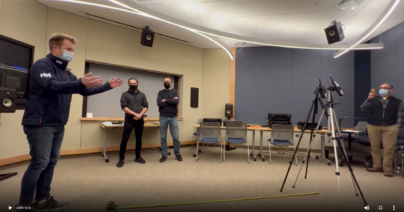 News
News
Acentech Records Guinness World Record for Loudest Clap
Acentech recorded the new Guinness World Record for the loudest clap! Steven Wallace clapped a peak measurement of 117 dBA, breaking the previous world record of 113 dBA….

by Tyler Tracy (a special thank you to Co-author Marielle Frederick for helping to put this together).
As members of the AEC community, we feel it is our responsibility to speak out on subjects we are knowledgeable and passionate about. We are becoming increasingly aware and active in taking steps to end systemic inequality and racism in the United States. More than ever, today’s climate clarifies the need to expose injustice and disseminate unbiased information to the public. An issue that has come into mainstream public discourse recently is the use of force against protesters in recent marches in support of the Black Lives Matter movement across the country.
Many police departments across the US have used Long Range Acoustic Device (LRAD) systems to aid in directing crowds and dispersing protesters, such as in the Lafayette Square protests on June 2, 2020. LRAD systems are a type of Acoustic Hailing Device (AHD), used to send messages over long distances. LRAD systems produce much higher sound levels (volume) than normal loudspeakers or megaphones.
Over shorter distances, LRAD signals are loud enough to cause pain in the ears of people in their path. LRAD systems have recently been used by police as “sonic weapons” to break up crowds. At first blush, the use of noise rather than physical force might seem like a safe, non-lethal way to move and direct crowds, but if used improperly they can cause permanent hearing damage. This is not only an issue for the intended targets; it also poses a significant threat to public safety officers working nearby.
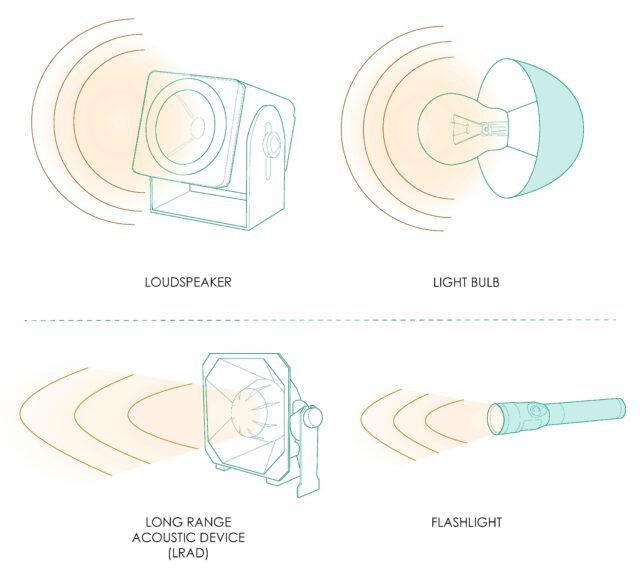
An LRAD is a loudspeaker-like device that emits a focused beam of sound. What makes these systems unique is that rather than transmitting sound like a loudspeaker in many directions (similar to the way a lightbulb emits light), LRAD systems transmit sound in a narrow beam (much like a flashlight).
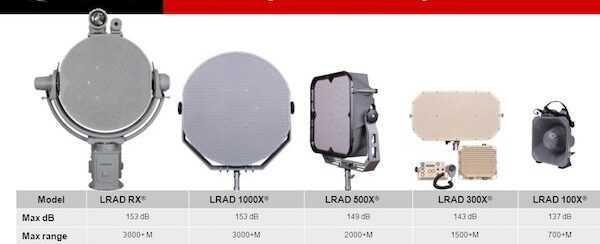
Smaller LRAD models are simple acoustic horns similar to those you see in megaphones or air-horns. Larger LRAD models employ a series of small loudspeakers to create a much more powerful, and narrower, beam of sound.
LRAD systems were developed for use by the US Navy in response to the al Qaeda bombing of the USS Cole in October of 2000. Their military function is to alert and communicate with approaching ships, and to repel potential attackers attempting to sabotage or pirate US Navy vessels. Since their development, LRAD systems have been purchased by the Anti-Terrorism/Force Protection Afloat Program Office as well as other military groups and civilian police in the United States and around the world.
LRAD military-grade systems were remodeled and remarketed as Acoustic Hailing Devices for civilian environments in the early 2000s. This is when municipal police departments in the United States began to acquire and use LRAD technology. For the first five years of police use in the US, LRAD systems communicated ‘unlawful assembly’ and other orders to crowds in major cities. LRAD use at this time did not come under public scrutiny because the devices were used in voice command mode at safe distances. By 2009 LRAD systems were being used at close distances in alarm mode (warning: LOUD) as non-lethal weapons for protester dispersal outside the G20 summit in Pittsburgh. Another instance of LRAD alarms being used in close quarters appears in a 2014 video (warning: LOUD). This close-in LRAD alarm deployment targeted people who were protesting the killing of Eric Garner.
In June of 2020, Richard Danforth (CEO of Genasys Inc., a manufacturer of LRAD systems) was quoted saying
“The crowd noise generated by large, and sometimes volatile protests, overwhelms bullhorns and vehicle public address systems rendering them essentially useless … LRAD voice broadcast systems enable new methods of policing that protect the public and law enforcement officers by promoting safer initial interactions. Using LRAD systems to communicate from safe standoff distances provides more time for mutual assessment, interaction and de-escalation.”
In practice, rather than simply communicating with protesters, LRAD systems can also be used to generate ear-splitting tones designed to cause pain and disperse crowds. In this way, the weaponized use of LRAD alarm mode poses safety issues for both users and receivers.
LRAD systems can produce maximum continuous sound pressure levels that vary, depending on model size, from 137 dBA to 162 dBA measured 3 feet from the device. For context, this is much louder than electronic dance music concerts, or a commercial jet take off at 300 feet. The chart below shows typical sound pressure levels that people experience in their daily lives compared to the sound pressure levels various LRAD models are capable of producing.
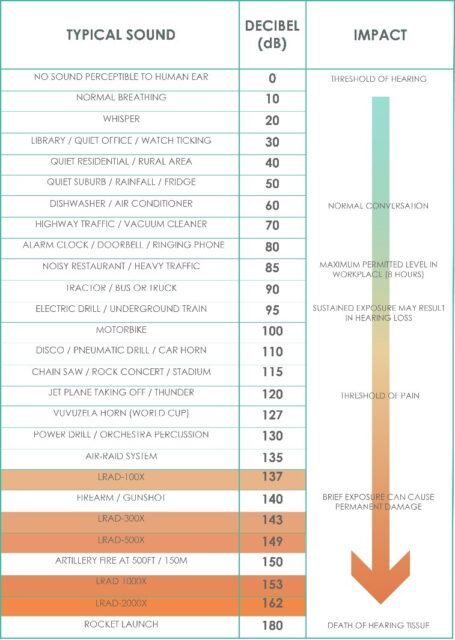
There are a few reasons why LRAD systems can be harmful beyond their innate ability to generate extremely loud sound pressure levels. One, they are not meant to be heard from up close. Sound pressure levels attenuate with distance, and like many other sound sources the farther you stand from an LRAD system, the less loud the device will sound. LRAD systems can be used to safely communicate from safe standoff distances. The Penn State University Institute for Non-Lethal Defense Technologies performed a “quick-look assessment” to develop operator/target safety cards in the early 2000’s, similar to the one shown below. These instructions are printed on the back of each LRAD system to “ensure operators have immediate access to operating guidelines.” Note that operators of LRAD systems are also in the hazard area, and subject themselves to potentially hazardous working conditions when using an LRAD.
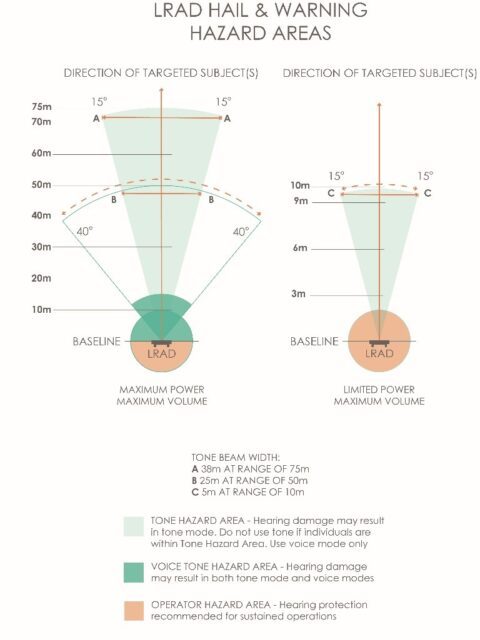
Unfortunately, safe operating distances for LRAD systems are not readily available in product specifications and data sheets accessible to the public.
LRAD systems are of particular concern when they operate in alarm mode (aka the alert or tone mode). In order to generate very high sound levels, these loudspeakers produce tones that occupy part of the most sensitive portion of the human hearing range: from 2,000 to 3,000 Hz, which can damage long-term hearing health (see Sensorineural Hearing Loss here).
The concern is elevated for LRAD systems because of the narrow beam width these devices produce. LRAD systems are highly directional, emitting most of their acoustic energy forward in a 30-degree beam. As quoted from a SWAT Officer testing an LRAD model 100X:
“I then had them [test subjects] walk across the 15-degree beam width of the unit and they could hear the change in the sound as it is intensified and louder as you walk into the focused direction of the unit.”
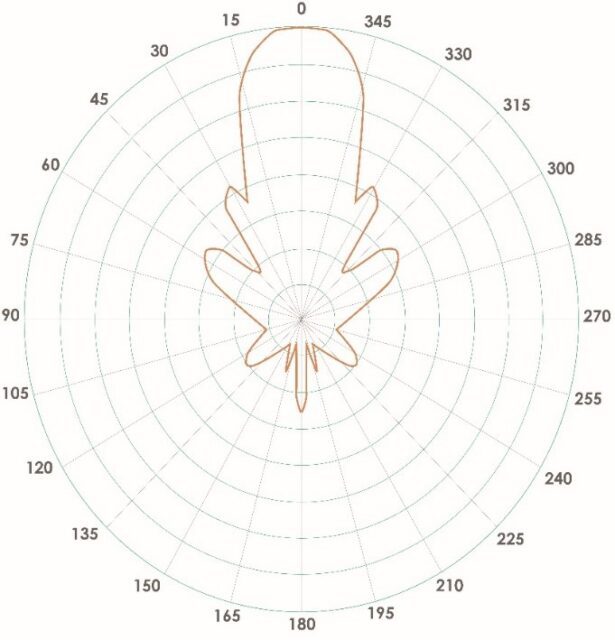
The LRAD sound field is innocuous until you are in the midst of it. Sound levels can go from hardly noticeable to intensely loud within a few footsteps, leaving targets without proper ability to distance themselves or prepare for a potentially dangerous noise exposure.
LRAD speakers are also extremely portable. They are are designed to be handheld, or mounted on vehicles, allowing for quick deployment and orientation changes. This means the danger zone where hearing damage is likely to occur can change quickly, leaving targets unprepared for a sudden escalation to very intense sound levels.
In July of 2020, The Acoustical Society of America (ASA) issued an official statement regarding the use of Acoustic Hailing Devices (AHDs), including LRAD systems, in which they called for three changes to the way LRAD systems are used. ASA has prioritized:
1. proper education and training in safe practices of these devices,
2. establishment and adherence of strict safety guidelines, and
3. further research into the potential health risks these devices pose.
Furthermore, the American Speech-Language-Hearing Association (ASHA) has issued a statement on permanent hearing loss, migraine, loss of balance, and other auditory symptoms that can arise from LRAD exposure. Children, the elderly, and those with preexisting sound injuries are at increased risk of harm from LRAD systems. ASHA’s statement notes:
“… the decibel level of speech presented through LRADs is unsafe, capable of causing temporary and permanent hearing loss for those in front of, behind, or on the periphery of the device.”
Charles Liberman, a Professor at Harvard Medical School and the Director of the Eaton-Peabody Lab at Massachusetts Eye and Ear, corroborates the ASHA statement with his own words regarding LRAD systems:
“There is no question that those devices are capable of causing permanent hearing damage and/or tinnitus or hyperacusis with a single exposure”.
Tinnitus and hyperacusis are just two examples of potential hazardous hearing conditions humans can develop as a consequence of LRAD use.
In a third-party investigation into minimum safe standoff distances for LRAD systems, the Ontario Ministry of Community Safety and Correctional Services released a report on its findings in 2011. The report recommends the LRAD 100X not be used at closer than 60 meters (200 feet) in alert mode and that the LRAD 300X not be used at closer than 200 meters (650 feet) in alert mode (maximum volume setting). Given that the National Institute of Health’s hearing threshold of pain is 130 dB, and the smallest LRAD model 100X is portable and capable of producing these levels within six feet of the device, clearly no manually-operated LRAD systems should be used without hearing protection for everyone who is close by.
From reports of those affected by LRAD misuse, we see the effects of these powerful devices when they are used against civilians. After being exposed to LRAD model 100X’s alarm mode in close range in 2014 Anika Edrei stated,
“For the first week, I had a migraine, and just a lot of facial pressure. Since the LRAD incident, I’ve been pretty freaked out about going back. I’m worried about what damage it caused and it could cause if I went out there again.”
Shay Horse, another person exposed to a close-range LRAD in 2014, continues,
“It feels like your eardrums are beating out of your head. It makes the side of your body that you’ve been hit on feel numb and that your sinuses are inflamed. I felt like I had blood coming out of my orifices. I heard the ringing for about a week.”
In recent months, LRAD systems and other forms of weaponized sound have been used more and more at protests surrounding racial injustice in the wake of the George Floyd killing. There is a common thread connecting these events: The hearing damage caused by LRAD and AHD systems is widespread. As long as these systems continue to be used on people exercising their constitutional right to protest, police and protestors alike continue to put their health at risk.
Speaking out about the dangers LRAD systems pose for public health is a way of standing in solidarity with those actively demonstrating for justice. It is our duty as members of the AEC community to use our voices to illuminate the public safety risks associated with LRAD and AHD systems.
____
Thank you to Ben Davenny, Bob Berens, Ben Markham, and Jeff Zapfe for their contributions.